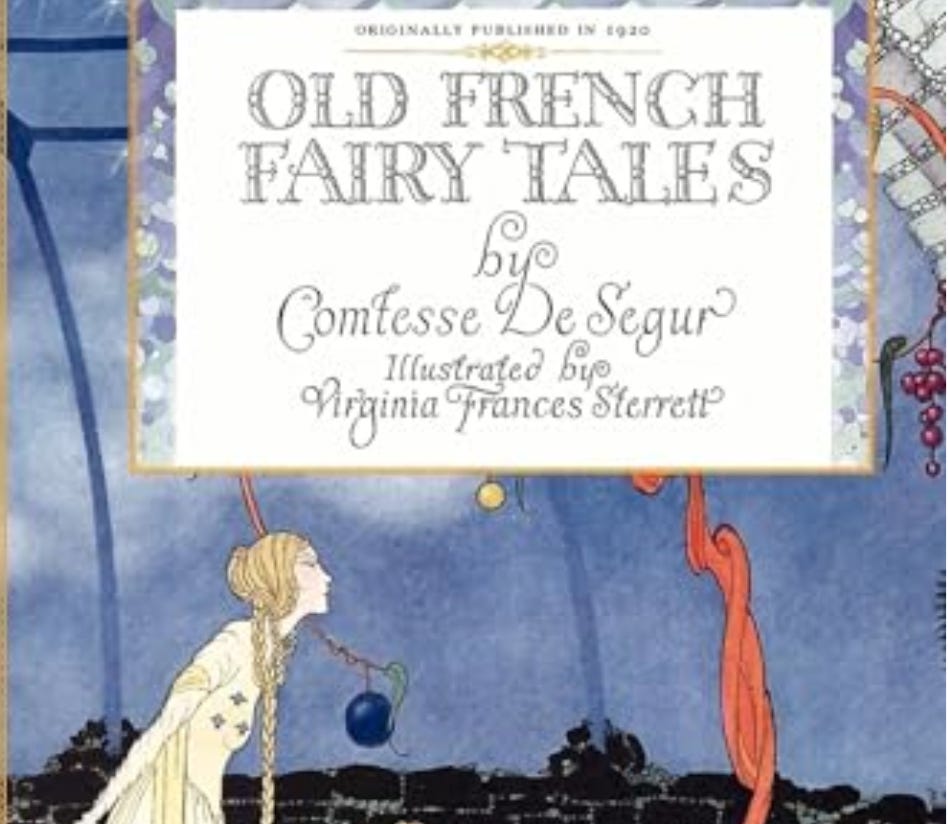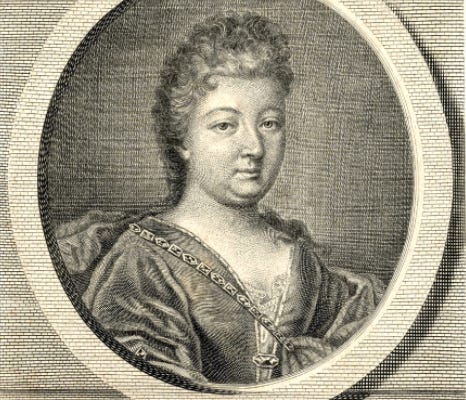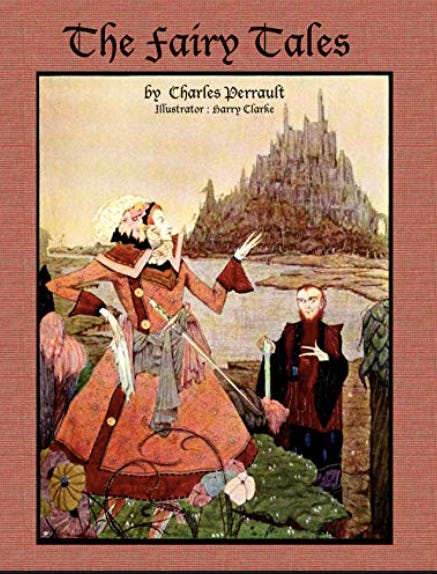14.41 - A Story of French Fairy Tales: Gain a better understanding of French culture
In this FREE le Bulletin we explore the foundation of French Fairy Tales and other ways of increasing the depth of your French cultural knowledge. Stories, acronyms, food names, a podcast interview +

Bonjour friends… I’m thrilled that you’re here again this week - bienvenue !
What’s happening in MyFrenchLife Magazine - three new articles.
We focus on gaining a deeper cultural understanding of France. We look at a couple of underestimated cultural components: Today, we feature these separate and important aspects of French culture to help you understand and aid your assimilation in France. Are you ready?
An interview with Emmanuel Fillion, The French sculptor who displays his extraordinary carving skills. Don’t miss the podcast!
Next, we explore the Foundations of French Fairytales
If you enjoy this edition, please note that every week there is another entirely different version of le bulletin exclusively for paying subscribers, and today that version is ‘14.41.a - Lyon: history and a genuine guide to the unique Bouchons Look for it in your inbox (or here) where you can access a preview or upgrade to enjoy it fully!
Judy - 19.10.’24
New articles in My FrenchLife Magazine — Let’s explore & read…
Did you know there are >3000 articles in MyFrenchLife Magazine, where savvy francophiles love to immerse themselves and indulge?
Here are the most recently published articles:
Reportage et Societe:
1.→How the French make life even more confusing than the subjunctive verb tense← Acronyms…
by Valérie Helmbreck Mascitti
This is the 7th article by Contributor Valérie Helmbreck Mascitti and she shares her experience and learnings of French Acronyms:
Nothing makes you more of an insider than acronyms, those multi-letter abbreviations for things big or small, physical or conceptual, long-lasting or ephemeral. Talking shorthand on any subject will make you look like you know something secret and elusive, apparent only to the cognoscenti.
→Read in full.
Gastronomie:
2.→ Food in France: What Do They Call It Where?
by Keith Van Sickle←
Keith is a long-time Contributor to MyfrenchLife Magazine. He lives between Silicon Valley and Provence. Keith is intrigued by the way different foods are referred to as different things across France. Keith says:
France has one of the world’s great cuisines, and the French really care about their food. So, you might think that they would use a common set of terms. An escargot is an escargot, n’est-ce pas? Well, not quite.
Mathieu Avanzi has written an entertaining and deeply researched book, Comme On Dit Chez Nous, about the terms used in France for all sorts of things, from food to pencils to tires and more. It is witty and informative and comes with maps showing where different terms are used, including in the francophone regions of Belgium and Switzerland.
Let’s look at a few foods and see what they're called in France.
→Read in full.
Arts and Culture:
3.→ Interview: Emmanuel Fillion, The art of cutting stone — Speaking Materially with Sarah Monk←
Born in Soissons, France, Emmanuel Fillion went to trade school at 16 to learn how to renovate historical monuments by hand, specialising in granite. He spent some years restoring churches, cathedrals, and monuments all over France until he felt the calling to create his work as an artist.
He says women and the female form are a constant source of inspiration. Dance is a strong theme in his work and began with a homage he did for Martha Graham who lives in the outdoor sculpture garden at the Wallis Theatre in Beverly Hills, LA. The models he used from a French dance school in order to make that sculpture impressed him hugely and, he says, gave him a lifetime of inspiration, adding that he felt he was surrounded by walking sculptures.
Read in full or listen to the podcast.
↓ CLICK IMAGE & read all the new articles on MyFrenchLife Magazine ↓
2. A Story of French Fairy Tales: Gain a better understanding of French culture
Understanding classic French fairytales offers profound insight into the cultural fabric of France. Tales like Charles Perrault's "Le Petit Chaperon Rouge" (Little Red Riding Hood) and "La Belle au Bois Dormant" (Sleeping Beauty) are deeply ingrained in French consciousness. These stories, along with "Le Chat Botté" (Puss in Boots) and "Cendrillon" (Cinderella), shape moral lessons and spark imagination from childhood.
Familiarity with these tales can aid in grasping French literary allusions and everyday expressions. For those aiming to immerse themselves in French culture, knowing these beloved stories provides common ground for conversation and a deeper understanding of French values and traditions.
This is a long one, so buckle up and stick with me.
Are you ready? Let’s dive in … C’est parti !
Foundations of French Fairy Tales by Veronica Royce
We all grew up hearing their stories, but how many of us know the history behind our favorite fairy tales? Did you know that fairy tales may never have existed as a literary genre, as they do today, without the influence of a few 17th Century French authors? That era's political and cultural context shaped these beloved stories and took them from oral tradition to published literature.
Once Upon a Time… il était une fois…
Before the phrase “fairy tale” was created, people passed down folk tales by word of mouth. These beloved stories changed incrementally over time and distance, with similar versions passed down through generations in different regions of the world. These stories were meant not just to entertain, but to pass along morals and cultural customs. Folk tales showed that life is not inherently good, but happy endings are possible through hard work, determination, and, perhaps, a bit of luck.
We cannot be sure when the first folk tale was created, nor how long these stories passed from generation to generation. It wasn’t until the 17th Century that folk tales started to be published in Europe, having first been embellished or modernized by their authors.
The first known use of the term “fairy tale” was by a female author in 17th-century France. Marie-Catherine Le Jumel de Barneville, Baroness d’Aulnoy, called her published folk stories contes de fées (“fairy tales”), birthing the term used thereafter for this widely popular literary genre. Her stories draw heavily from folk tales and often involve heroines overcoming great obstacles to find happiness at the end.
Her desire to dream up fairytale endings was likely inspired by her own storied life.
The Birth of the Fairy Tale
Madame d’Aulnoy’s life seems to have been as wild as a modern-day soap opera, including an arranged marriage, a conspiracy to have her husband murdered, and, possibly, espionage.
She was born in Barneville-la-Bertran in Normandy and was given in a pre-arranged marriage at the age of fifteen to François de la Motte, Baron d’Aulnoy, a man thirty years her senior.
The marriage between the Baron and Madame d’Aulnoy was not a happy one, likely exacerbated by the Baron’s drinking and gambling problems.
Just a few years after their marriage, the Baron was accused of treason and spent three years in the Bastille. His two accusers are thought to have been the lovers of Madame d’Aulnoy and her mother. And, Madame d’Aulnoy is thought to have conspired with them to rid herself of her husband.
The Baron eventually convinced the court of his innocence and his two accusers were executed. At that same time, a warrant was served for Madame d’Aulnoy’s arrest and she was forced to flee France. She then spent many years abroad and may have worked as a spy to earn her way back to Paris.
Once back in France, Madame d’Aulnoy hosted literary salons in her Parisian home. Salons became fashionable in 17th Century France as a way for like-minded individuals to gather in homes and discuss or create written works, away from the criticism-prone court of French King Louis XIV. Salons especially gave women like Madame d’Aulnoy and her female contemporaries an outlet for enlightened conversations in what was an otherwise male-dominated society.
At many literary salons of the time, women created or adapted folk stories to include subtle storylines as a way of complaining about the king or their unhappy marriages. Women of the time did not have access to formal education and salons offered a chance for them to learn from, and commiserate with, each other.
It is in this environment that Madame d’Aulnoy published her fairy tales in the volumes Les Contes de Fées in 1697-1699 and Contes Nouveaux ou Les Fées à la Mode (New Tales, or Fairies in Fashion) in 1698. Her tales were not suitable for children and written in a conversational style that went out of fashion by the 19th Century. Unfortunately, today, Madame d’Aulnoy is not widely recognized for her important role in bringing fairy tales to the written page.
Perrault: The Father of Fairy Tales
Around the same time that Madame d’Aulnoy published her Contes de Fées, and more than 100 years before the Brothers Grimm penned their works, French author Charles Perrault published his Tales of Mother Goose in 1697.
Perrault was born in Paris in 1628 and dropped out of school when he thought his teachers were being unfair.
He later studied law and practiced architecture, where his success led him to influence the construction of Versailles and the Louvre.
His review praising modern works brought about the “Quarrel of the Ancients and the Moderns” in literary and artistic circles. It wasn’t until he stepped back from his career, however, that his success as a writer really took off.
Perrault was in his mid-60s by the time he compiled the stories that would make up his Tales of Mother Goose. He first attributed his fairy tales to his youngest son, Pierre, and his later works solely to the stock character Mother Goose.
Although his stories were heavily based on earlier folk tales, his style was so popular that he is credited with establishing fairy tales as a new literary genre.
Unlike his contemporary Madame d’Aulnoy, Perrault’s stories appealed to both adults and children. He peppered his tales with morals and messages about how to navigate the world, while his plots sparked the imagination of readers of all ages.
His adaptations of folk tales include such well-known titles as “Cinderella,” “Bluebeard,” “Puss in Boots,” and “Little Red Riding Hood.” However, readers unfamiliar with Perrault may find surprising differences in his versions than what they are accustomed to. (*Spoiler:* Red Riding Hood gets gobbled up by the wolf at the end and Sleeping Beauty has an ogre for a mother-in-law).
It is believed Perrault’s tales heavily influenced the works of the Brothers Grimm. And although the Brothers may be more of a household name than Perrault, without his influence, fairy tales may never have existed as we know them today.
Ever After
It is hard to imagine what our world would be like had fairy tales never been published.
They have inspired so much of our current popular culture – from Disney movies to TV shows to advertisements selling everything from self-tanner (imagine Snow White with a Tan) to chocolate (a Kit Kat satisfying the Wolf’s cravings). Their universal appeal and simple storylines continue to offer the ultimate escapism.
The influence that Madame d’Aulnoy and Charles Perrault have had on popular culture is hard to deny. And while any diehard fan of fairy tales should be familiar with the Brothers Grimm and the works of Charles Perrault, unfortunately, Madame d’Aulnoy is far from a household name… yet. Thankfully, it may not be the end of the story for Madame.
#MeToo Era
The feminist themes in her contes have gained more attention in the current #MeToo era. Many recent articles have identified her influence on the genre and two English translations of her works were published in the past two years by Black Coat Press and Princeton University Press.
It is easy to see that the influence of both Madame d’Aulnoy and Charles Perrault continues to this day.
Here is hoping their contes de fées will live on ever after.
Have you read these historic Fairy tales in French? Please share your thoughts and experiences in the Comments section below.
Image Credits:
1. Marie-Catherine d’Aulnoy via Wikipedia
2. Charles Perrault via Fairytalez.com
3. Fairy Tales via Amazon
4. Book via Princeton University Press
5. Book via Black Coat Press
Further reading:
Madame d’Aulnoy, the mysterious fairy-tale queen | Princeton University Press
The Project Gutenberg eBook of The Fairy Tales of Charles Perrault, by Charles Perrault, et al
French fairytales: Amélie Nothomb gives ‘Barbe-Bleue’ a makeover
The Island of Happiness: French Feminist Fairytales get a new translation
Were you previously aware of the foundations of French fairy tales?
Which are your favourite Fairy Tales?
3. …And don’t forget to follow us on Instagram → @MaVieFrançaise
Each day, each week offers something fresh!
Bursting with news, views and articles, video chats, poetry, introductions to new magazine contributors… and more… follow us and join in @maviefrancaise … See you there soon, I hope.
Jennifer’s popular regular Pilgrimage Report:
The only constant at the moment is the weekly post by Jennifer Andrewes on her solo pilgrimage - Via Francigena - to Rome: 2500km watch out for it…
Here Jennifer is, after >100 days…
Having crossed northern France, then the St Bernard Pass, (the third highest) from Switzerland to Italy, then to Lucca for a rest day, then, onward toward Roma, where she’ll be in 6-7 days from now. You can read the details in her weekly guest post on our Instagram account @maviefrancaise
A total of >2200km so far!


Image credit: Copyright Jennifer Andrewes
Do you have any questions for Jennifer Andrewes?
4. “Thank you for subscribing to ‘le Bulletin’ newsletter” Judy MacMahon
I hope to see you here again soon
Judy MacMahon
Fondatrice
MyFrenchLife.org
You can always email me at info@myfrenchlife.org
Here’s how you can stay in touch & personalise your le Bulletin experience:
If you like this le Bulletin newsletter of MyFrenchLife.org Magazine? Please forward it or Share it with a friend. Surprise them and help us grow.
Loved a story? Disliked it? Drop me a note or just write to say ‘bonjour’.
Did a friend forward this to you? Sign up to get le Bulletin newsletter weekly.
If you’d like to be sure you GET or NOT GET posts/emails about our French Book Club, you can personalise your account. toggle ON or OFF.
And… finally, you can immerse yourself in the archive of le Bulletin Newsletter here & the MyFrenchLife Magazine archive of >3000 articles
'le Bulletin' is a reader-supported publication. To receive new posts and support my work, consider becoming a free or paid subscriber.








